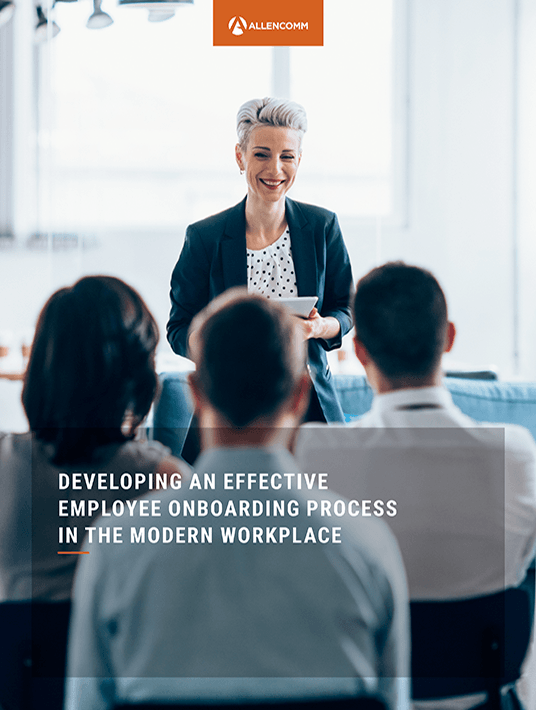5 Modern Best Practices
Effective employee onboarding is essential for retaining new hires, increasing productivity, and supporting the bottom line. Unfortunately, it's not always done well. The US and the UK together spend around $37 billion dollars annually to retain unproductive employees who do not understand their jobs [1]. Presumably, that money would be better spent retraining productive employees, and research shows that the modern workforce wants more corporate training. Randstad found that 75% of survey respondents feel they need more training [2] just to stay up-to-date.

The modern workforce demands employee onboarding that develops their technical skills, leadership skills, and enables them to perform well in the role for which they were hired. As you set out to plan your employee onboarding experience, some of these training best practices that might help.
1. Keep Employee Onboarding Simple
New hires can feel overwhelmed by their new responsibilities, company culture, and expectations. Onboarding shouldn’t be another stressor. Instead, it should make employees feel supported in their new role.
To that end, try using a phased approach for your new-hire journey. When designing the learning experience, consider the following: What does your employee need to know on day one? One week? 30 days? 90 days? Using a phased approach limits goals to what seems more immediate, making the end-goal seem more attainable. Some User Interface designs have accomplished this by showing progress with a series of meters or bars.
In the 70:20:10 leadership development model, learning comes from 70% challenging projects, 20% coaching and mentorship, and 10% structured learning. But, let's not limit training interventions to 10% formal training. You can simplify the onboarding experience by adding structure to mentoring and challenging projects. For example, you can also provide mentors with resources to support new hires as they navigate specific projects. The concerted effort will go a long way to deploy cohesive on-the-job training. Some jobs will require upfront knowledge and skills from structured training followed by on-the-job experiences and challenges. For other jobs, microlearning courses interspersed with challenging projects will suffice.
2. Make It Modern
In the modern workplace, employees expect training that reflects their high-tech personal lives. Though Instructor-Led Training is still prevalent in corporate training, the days of paper manuals are pretty much gone. Including digital learning features has a positive impact on learning outcomes. For instance, a Harvard professor found that adding something as simple as a poll to learning activities can double learning gains and employee retention [3]. Using eLearning tools such as simulations, interactive video, and gamification for training can more effectively engage and train new employees. So, make use of whatever training technology you have.
That being said, don’t just throw money at technology. Your use of training technology should be a strategic part of your overall learning experience.
3. Show Your Interest
You hired your employees for their respective skill sets and personalities. Don’t forget why you hired them as they navigate through the onboarding process. Traditionally, training immerses new hires in company history and values. But this approach may actually create tension [4] and downplay a new employee’s individuality.
Instead of typical indoctrination, focus employee onboarding on promoting individuality among new hires. Activities around individual employee values will emphasize their unique knowledge and skills. Then, connect those values and skills with their new role to empower your employees to feel confident in their ability to succeed.
4. Remember Objectives
Think about the knowledge and behaviors you want employees to demonstrate at the end of their onboarding experience and work backward from there. Your training objectives should build upon one another and create a matrix of interconnected ideas and skills leading to an ideal state. However, this process can be difficult if the training doesn't have behavior-based goals. In that case, provide new hires with a roadmap that shows their progress through the training content based upon their understanding of the material.
5. Don’t Forget Who You’re Training
In the modern workforce, one size does not fit all. So, keep the individual characteristics and experiences of your learners in mind as you put together your learning strategy. Most digital learning solutions enable a degree of customization or personalization with the User Interface design and curriculum pathways. It would be untenable to create a learning path for each individual employee, but factors such as prior knowledge, job function, and performance can all play a role in creating unique learning experiences for functional groups.
Conclusion
Effective employee onboarding for the modern workforce takes planning, and employees are demanding a better experience. You can provide an onboarding experience that will help your new hires grow into high-performing employees by using these best practices. In short, consider your audience composition, design for structure and simplicity in your learning experience, and set practical objectives.
For more actionable insights into employee onboarding for the modern workforce, download our eBook Developing An Effective Employee Onboarding Process In The Modern Workplace!
References:
[1] [Infographic] The Onboarding New Hire Statistics You Need to Know (with 2018 Updates)
[2] Global Report Randstad Workmonitor Q3, 2017
[3] The Benefit of Interactive Learning
[4] Reinventing Employee Onboarding









